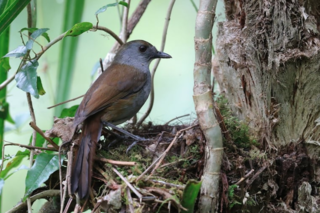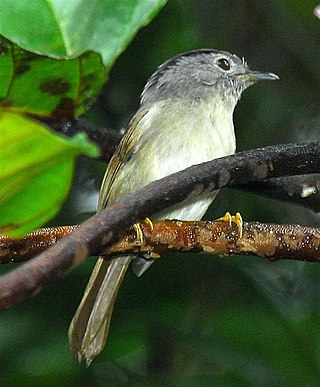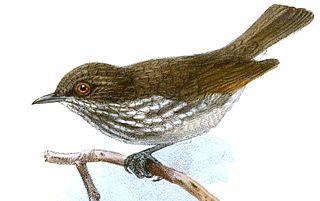Old World warblers are a large group of birds formerly grouped together in the bird family Sylviidae. They are not closely related to the New World warblers. The family held over 400 species in over 70 genera, and were the source of much taxonomic confusion. Two families were split out initially, the cisticolas into Cisticolidae and the kinglets into Regulidae. In the past ten years they have been the subject of much research and many species are now placed into other families, including the Acrocephalidae, Cettiidae, Phylloscopidae, and Megaluridae. In addition some species have been moved into existing families or have not yet had their placement fully resolved. A smaller number of warblers, together with some babblers formerly placed in the family Timaliidae and the parrotbills, are retained in a much smaller family Sylviidae.

The white-eyes are a family, Zosteropidae, of small passerine birds native to tropical, subtropical and temperate Sub-Saharan Africa, southern and eastern Asia, and Australasia. White-eyes inhabit most tropical islands in the Indian Ocean, the western Pacific Ocean, and the Gulf of Guinea. Discounting some widespread members of the genus Zosterops, most species are endemic to single islands or archipelagos. The silvereye, Zosterops lateralis, naturally colonised New Zealand, where it is known as the "wax-eye" or tauhou ("stranger"), from 1855. The silvereye has also been introduced to the Society Islands in French Polynesia, while the Japanese white-eye has been introduced to Hawaii.

The pin-striped tit-babbler, also known as the yellow-breasted babbler, is a species of bird in the Old World babbler family Timaliidae that is found in South and Southeast Asia.

The malia is a medium-sized babbler-like passerine. It has an olive-green plumage, yellowish head and chest, and pinkish-brown bill. The young is duller than the adult. It is the only member of the genus Malia.

The brown tit-babbler is a species of bird in the family Timaliidae. It is endemic to the Philippines. Its natural habitats are tropical moist lowland forest and or tropical moist montane forest.

The Visayan miniature babbler or the Leyte plumed-warbler is a bird species in the family Cisticolidae.

The rusty-crowned babbler is a species of bird in the family Zosteropidae. It is native to the southern Philippines on the islands of Mindanao and Dinagat Islands and Basilan. Its natural habitat is tropical moist lowland forest.

The Visayan babbler also known as the Visayan Black-crowned Babbler. is a species of bird in the family Zosteropidae. It is endemic to the Philippines. It is found on Samar, Leyte and Bohol. Its natural habitat is tropical moist lowland forest. It was formerly conspecific to the northern population of the Calabarzon black-crowned babbler but has since been split as a species due to differences in its yellowish throat and whiter belly.

The Mindanao pygmy babbler is a bird species endemic to the Philippines. It had been placed in the family Timaliidae, but it is a close relative of the white-eyes, however, and many taxonomists now place it in the family Zosteropidae..

The Bagobo babbler or Bagobo robin is a monotypic species of bird with its taxonomy undergoing numerous changes and is currently classified as Muscicapidae or an old world flycatcher. It is endemic to the Philippines only found in Mindanao. It was once deemed "unquestionably the Philippines most secretive bird" by ornithologist Robert Kennedy. It habitat are in moist montane forests up to 2,030 meters above sea level. It is named after the Bagobo tribe.

The white-throated babbler is a species of bird in the family Leiothrichidae. It is endemic to Myanmar.

The slender-billed babbler is a species of bird in the family Leiothrichidae. It is found in Bangladesh, Nepal, Northeast India and possibly Myanmar. Its natural habitat is subtropical or tropical seasonally wet or flooded lowland grassland. It is threatened by habitat loss.

Sylvioidea is a superfamily of passerine birds, one of at least three major clades within the Passerida along with the Muscicapoidea and Passeroidea. It contains about 1300 species including the Old World warblers, Old World babblers, swallows, larks and bulbuls. Members of the clade are found worldwide, but fewer species are present in the Americas.

Alcippe is a genus of passerine birds in the monotypic family Alcippeidae. The genus once included many other fulvettas and was previously placed in families Pellorneidae or Timaliidae.

Zosterornis is a genus of passerine birds in the white-eye family Zosteropidae. The five species in the genus are endemic to the Philippines.

The Visayan pygmy babbler is a bird species endemic to the Philippines on the islands of Leyte and Samar. It was conspecific with the Mindanao pygmy babbler under the common name of "pygmy babbler".Its natural habitats are tropical moist lowland forests and or tropical moist montane forests.

The Mindanao miniature babbler also known as the Mindanao plumed-warbler is a bird species in the family Cisticolidae. It was formerly conspecific with the Visayan miniature babbler. This bird is endemic to the Philippines found only on the island of Mindanao. Its natural habitats are tropical moist lowland forests and tropical moist montane forests. At just 7 centimeters long and weighing 5 grams, it is one of the smallest birds in Asia.

The jungle babblers are a family, Pellorneidae, of mostly Old World passerine birds belonging to the superfamily Sylvioidea. They are quite diverse in size and coloration, and usually characterised by soft, fluffy plumage and a tail on average the length of their body, or longer. These birds are found in tropical zones, with the greatest biodiversity in Southeast Asia and the Indian subcontinent.

Mixornis is a genus of passerine birds in the Old World babbler family Timaliidae.
















